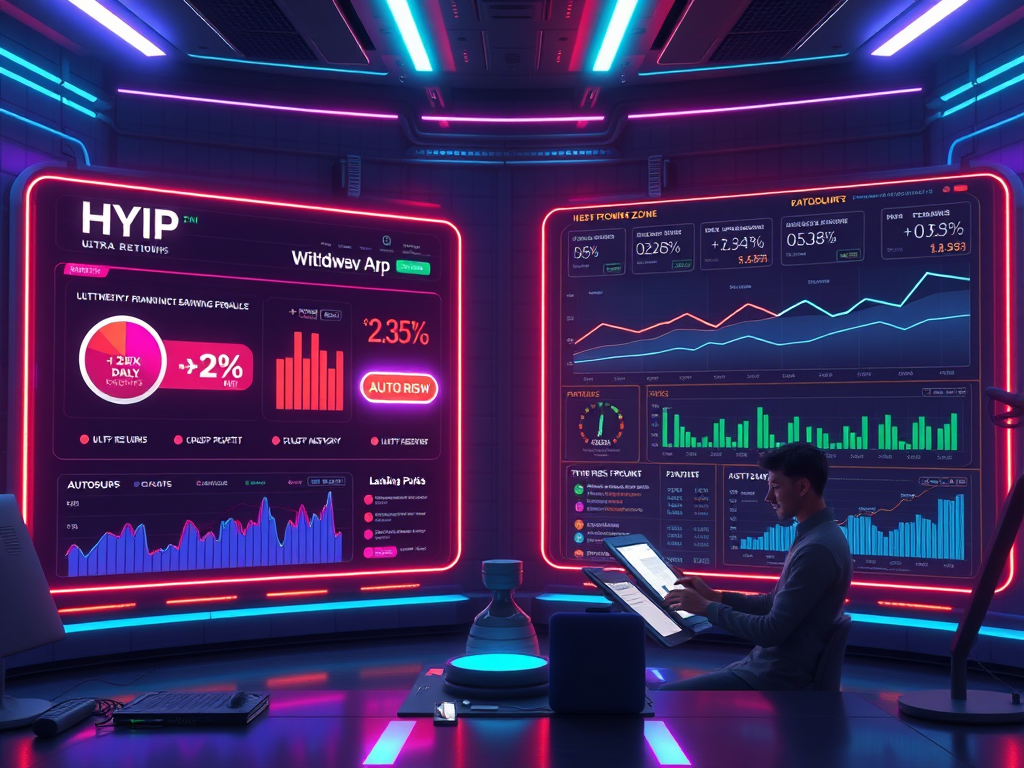Investing in HYIPs has added to the complexity of the online investment landscape, especially with the rise of Ponzi schemes. Both promise high returns with minimal effort, yet they operate on different principles. The key question is, how can you differentiate between the two? More importantly, how can you safely navigate this space to avoid falling into scams? This article will explore these two investment models in-depth, shedding light on their operations, psychological appeal, and how you can protect yourself.
What is Investing in HYIPs?
A High-Yield Investment Program (HYIP) is an online investment platform that claims to provide exceptionally high returns in a short period of time. These programs often promise returns of 40%, 50%, or more per day. This is incredibly tempting to many investors. However, it is important to note that while many HYIPs are fraudulent, not all are. Some operate legitimately, investing funds into real business ventures, though the risks remain high.
Important Tip: Before investing in a HYIP, always conduct thorough research. If the program promises returns that seem too good to be true, it’s a red flag. Additionally, if it lacks transparency about how your money is being used, it’s likely a scam. Websites like theHYIPs.net or similar review platforms can offer valuable insight into the program’s legitimacy.
What is a Ponzi Scheme?
A Ponzi scheme is a type of financial fraud. It operates on the principle of using new investors’ money to pay returns to earlier investors instead of generating real profits. This system relies entirely on constant recruitment of new investors to function. As soon as the flow of new money slows down, the Ponzi scheme collapses.
Ponzi schemes promise high returns with minimal risk. They may operate smoothly for a time, but they are not sustainable. The organizers typically disappear when the scheme falls apart, leaving most investors with significant losses.
Key Indicators of a Ponzi Scheme:
- Unrealistically high returns with little or no risk.
- No transparency regarding where the money is being invested.
- Lack of real business operations or investments.
Key Differences Between Investing in HYIPs and Ponzi Schemes
Understanding the fine line between a legitimate HYIP and a Ponzi scheme is crucial. Here are the primary differences:
1. Investment Structure
- HYIP: Funds are often invested in businesses or financial markets, though returns can be unpredictable.
- Ponzi Scheme: There are no real investments. Money is paid from new investors to older ones.
2. Transparency
- HYIP: Some HYIPs disclose where the funds are being used, such as in trading, forex, or other financial markets.
- Ponzi Scheme: These schemes offer no transparency and refuse to explain how funds are being used.
3. Sustainability
- HYIP: While some HYIPs may last for months or even years, they are still high-risk ventures.
- Ponzi Scheme: Ponzi schemes eventually collapse when the influx of new investors slows down.
4. Marketing Strategies
- HYIP: While some HYIPs incentivize investors to refer new participants, their focus is primarily on the investment itself.
- Ponzi Scheme: Recruitment is the primary focus. The promise of high returns often only materializes if you recruit others.
The Psychological Element: Why Do People Fall for These Schemes?
Understanding the psychology behind investing in HYIPs and Ponzi schemes is essential. It helps in making informed decisions. Why do people continue to fall for these high-risk investments?
1. Greed and Instant Gratification
People are naturally drawn to quick money-making opportunities. The promise of high returns in a short time is tempting. With little effort, it can cloud an investor’s judgment. Many investors are willing to take significant risks in exchange for the chance of fast profits.
2. Social Proof
When people see others profiting from a scheme, they are more likely to believe they can too. This is known as social proof. As more individuals promote their success stories, others may feel pressured to invest.
3. FOMO (Fear of Missing Out)
When people see others succeeding, they may experience FOMO (Fear of Missing Out). This fear can lead them to make impulsive decisions and rush into investments that appear to offer immediate rewards.
Real-Life Examples: Success Stories and Cautionary Tales
To understand these investment models better, let’s look at a few real-life examples:
Success Story: A Legitimate HYIP
In 2024, a user invested in a HYIP focused on cryptocurrency trading. Over two months, the investor made $10,000. This was due to the platform’s transparency and solid investment strategies. The program generated profits, which were then distributed to investors. The investor was cautious, conducting research and consulting forums before committing.
Cautionary Tale: The Collapse of a Ponzi Scheme
In 2023, a Ponzi scheme disguised as a real estate investment platform collapsed, leaving thousands of investors stranded. The scheme depended heavily on recruitment, offering new investors large payouts for bringing in others. When the recruitment slowed, the system fell apart, and the organizers vanished with millions of dollars.
What to Do to Protect Yourself
Knowledge is power when it comes to online investments. Here are practical steps you can take to ensure you’re investing wisely:
1. Research
Before investing in any program, do thorough research. Look for reviews and feedback on platforms like theHYIPs.net. Checking other users’ experiences on forums and websites can help you make a more informed decision.
2. Transparency
Invest in platforms that provide full transparency about their operations. If a platform is unwilling to disclose where your money is being invested, it’s a red flag.
3. Start Small
Only invest money you can afford to lose. High-risk platforms like HYIPs are volatile. It’s important not to risk more than you’re prepared to lose.
4. Avoid Unrealistic Promises
If an investment offers returns that sound too good to be true, they probably are. Be cautious and avoid programs that promise guaranteed high returns with little risk.
Final Thoughts: Can You Profit from Investing in HYIPs?
While the risks associated with HYIPs are high, it is possible to profit from them. However, this requires careful selection of programs, patience, and a willingness to accept some risk. The key is not to chase fast profits but to make well-thought-out, calculated decisions.
Conclusion: Taking Action and Starting Your Journey
If you’ve read this far, you’re likely considering whether or not to dive into the world of HYIPs. The bottom line is this: yes, it is possible to earn money from HYIPs, but only if you approach them with caution, conduct thorough research, and stay vigilant.
The secret to success is not getting rich overnight but in understanding the market, being patient, and making informed decisions. By following the advice and strategies outlined here, you’ll increase your chances of success. A legitimate HYIP can offer substantial returns without putting your funds at unnecessary risk.
Remember, success in this space doesn’t happen by luck; it comes from careful planning, a level-headed approach, and a willingness to learn as you go. If you’re ready to take the first step toward financial freedom, the world of HYIPs may be worth exploring, but always remember to start small and stay informed.


